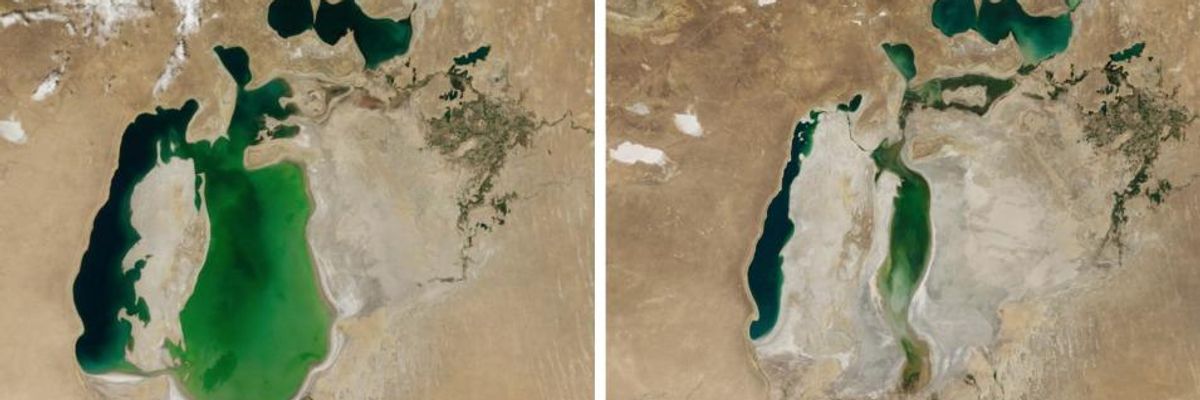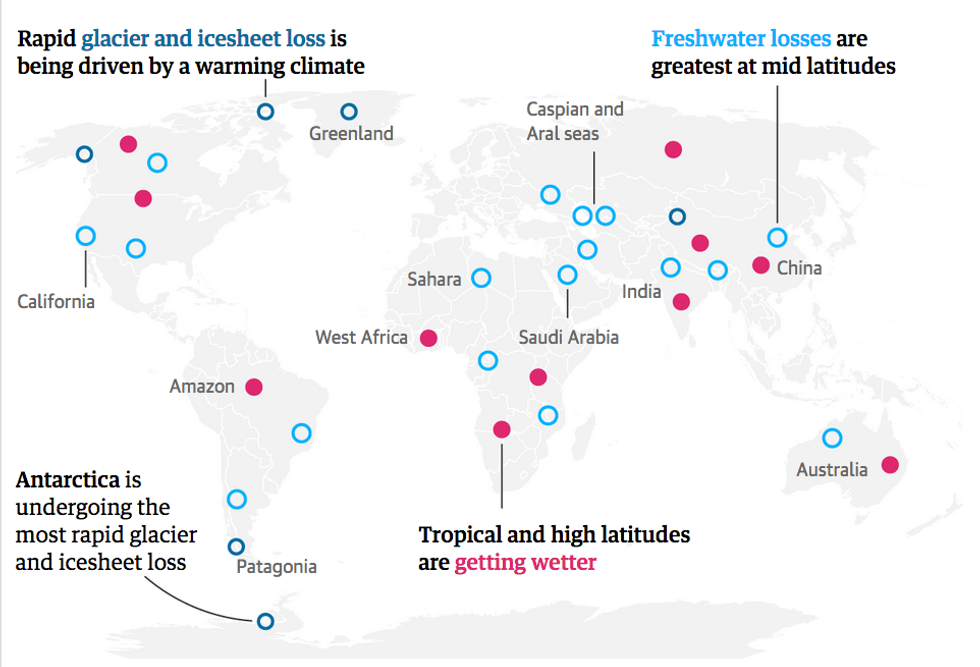

SUBSCRIBE TO OUR FREE NEWSLETTER
Daily news & progressive opinion—funded by the people, not the corporations—delivered straight to your inbox.
5
#000000
#FFFFFF
To donate by check, phone, or other method, see our More Ways to Give page.


Daily news & progressive opinion—funded by the people, not the corporations—delivered straight to your inbox.

The Aral Sea, seen in a NASA satellite image, in 2000 on the left versus 2017 on the right. (Image: Modis/Terra/NASA)
With a first-of-its-kind satellite study, NASA scientists have identified more than 30 parts of the globe where the depletion of freshwater has been most dramatic, largely due to human activity and the climate crisis.
Parts of India, the Middle East, Australia, the Arctic, Antarctica, and California were among the places pointed out in the new study published in Nature on Wednesday, as areas where an overuse of groundwater resources from irrigation, agricultural, and industry projects, as well as the loss of glaciers and ice sheets, have led to water shortages.

The findings showed a "clear human fingerprint" on the drying out of the Earth, the authors of the report told the Guardian.
\u201cEarth\u2019s wet areas are getting wetter and dry areas are getting drier due to a variety of factors, including human water management, climate change and natural cycles.\u201d— NASA Earth (@NASA Earth) 1526492898
Aside from the warming planet's effect on rapidly melting polar ice, the extraction of water from rivers like those that feed into the Aral Sea in Central Asia, for the purposes of farming and industrial use, have resulted in dramatic losses of freshwater.
Over-extraction has been especially problematic in parts of India and China, according to the study, causing a rapid decline in the availability of water despite normal rainfall levels.
"The fact that extractions already exceed recharge during normal precipitation does not bode well for the availability of groundwater during future droughts," wrote the study's authors.
"This report is a warning and an insight into a future threat," Jonathan Farr of the charity WaterAid told the Guardian. "We need to ensure that investment in water keeps pace with industrialization and farming. Governments need to get to grips with this."
The worst-affected regions were uninhabited parts of the globe like Antarctica where 10 percent of the icy continent's glaciers are now in retreat, according to a study published last month.
\u201cFreshwater is present in lakes, rivers, soil, snow, groundwater and glacial ice. Its loss in the ice sheets at the poles -- attributed to climate change -- has implications for sea level rise.\u201d— NASA Earth (@NASA Earth) 1526492898
Dear Common Dreams reader, The U.S. is on a fast track to authoritarianism like nothing I've ever seen. Meanwhile, corporate news outlets are utterly capitulating to Trump, twisting their coverage to avoid drawing his ire while lining up to stuff cash in his pockets. That's why I believe that Common Dreams is doing the best and most consequential reporting that we've ever done. Our small but mighty team is a progressive reporting powerhouse, covering the news every day that the corporate media never will. Our mission has always been simple: To inform. To inspire. And to ignite change for the common good. Now here's the key piece that I want all our readers to understand: None of this would be possible without your financial support. That's not just some fundraising cliche. It's the absolute and literal truth. We don't accept corporate advertising and never will. We don't have a paywall because we don't think people should be blocked from critical news based on their ability to pay. Everything we do is funded by the donations of readers like you. Will you donate now to help power the nonprofit, independent reporting of Common Dreams? Thank you for being a vital member of our community. Together, we can keep independent journalism alive when it’s needed most. - Craig Brown, Co-founder |
With a first-of-its-kind satellite study, NASA scientists have identified more than 30 parts of the globe where the depletion of freshwater has been most dramatic, largely due to human activity and the climate crisis.
Parts of India, the Middle East, Australia, the Arctic, Antarctica, and California were among the places pointed out in the new study published in Nature on Wednesday, as areas where an overuse of groundwater resources from irrigation, agricultural, and industry projects, as well as the loss of glaciers and ice sheets, have led to water shortages.

The findings showed a "clear human fingerprint" on the drying out of the Earth, the authors of the report told the Guardian.
\u201cEarth\u2019s wet areas are getting wetter and dry areas are getting drier due to a variety of factors, including human water management, climate change and natural cycles.\u201d— NASA Earth (@NASA Earth) 1526492898
Aside from the warming planet's effect on rapidly melting polar ice, the extraction of water from rivers like those that feed into the Aral Sea in Central Asia, for the purposes of farming and industrial use, have resulted in dramatic losses of freshwater.
Over-extraction has been especially problematic in parts of India and China, according to the study, causing a rapid decline in the availability of water despite normal rainfall levels.
"The fact that extractions already exceed recharge during normal precipitation does not bode well for the availability of groundwater during future droughts," wrote the study's authors.
"This report is a warning and an insight into a future threat," Jonathan Farr of the charity WaterAid told the Guardian. "We need to ensure that investment in water keeps pace with industrialization and farming. Governments need to get to grips with this."
The worst-affected regions were uninhabited parts of the globe like Antarctica where 10 percent of the icy continent's glaciers are now in retreat, according to a study published last month.
\u201cFreshwater is present in lakes, rivers, soil, snow, groundwater and glacial ice. Its loss in the ice sheets at the poles -- attributed to climate change -- has implications for sea level rise.\u201d— NASA Earth (@NASA Earth) 1526492898
With a first-of-its-kind satellite study, NASA scientists have identified more than 30 parts of the globe where the depletion of freshwater has been most dramatic, largely due to human activity and the climate crisis.
Parts of India, the Middle East, Australia, the Arctic, Antarctica, and California were among the places pointed out in the new study published in Nature on Wednesday, as areas where an overuse of groundwater resources from irrigation, agricultural, and industry projects, as well as the loss of glaciers and ice sheets, have led to water shortages.

The findings showed a "clear human fingerprint" on the drying out of the Earth, the authors of the report told the Guardian.
\u201cEarth\u2019s wet areas are getting wetter and dry areas are getting drier due to a variety of factors, including human water management, climate change and natural cycles.\u201d— NASA Earth (@NASA Earth) 1526492898
Aside from the warming planet's effect on rapidly melting polar ice, the extraction of water from rivers like those that feed into the Aral Sea in Central Asia, for the purposes of farming and industrial use, have resulted in dramatic losses of freshwater.
Over-extraction has been especially problematic in parts of India and China, according to the study, causing a rapid decline in the availability of water despite normal rainfall levels.
"The fact that extractions already exceed recharge during normal precipitation does not bode well for the availability of groundwater during future droughts," wrote the study's authors.
"This report is a warning and an insight into a future threat," Jonathan Farr of the charity WaterAid told the Guardian. "We need to ensure that investment in water keeps pace with industrialization and farming. Governments need to get to grips with this."
The worst-affected regions were uninhabited parts of the globe like Antarctica where 10 percent of the icy continent's glaciers are now in retreat, according to a study published last month.
\u201cFreshwater is present in lakes, rivers, soil, snow, groundwater and glacial ice. Its loss in the ice sheets at the poles -- attributed to climate change -- has implications for sea level rise.\u201d— NASA Earth (@NASA Earth) 1526492898